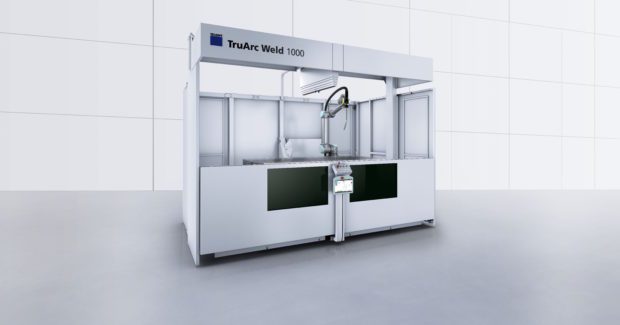When (and How) to Automate Sheet Metal Welding
Cobotic welding systems occupy the gap between fast and heavy industrial robots and manual welding. They also challenge the paradigm that welding automation is strictly a high-volume game.
Posted: February 5, 2021
CUTTING EDGE COLUMN
BY TOM BAILEY
Most sheet metal fabricators at some time or another must put some thought into welding parts. For some, it’s minimal: If all you’re making is simple boxes and spot-welding works well for that, it’s hard to imagine why you’d put much more thought into the process. For most fabricators, though, welding is a more serious consideration, and requirements on the factory floor may evolve over time, too.
Like almost every other fabrication process, welding can be performed manually by a human being with a tool or automated. Automation, speaking in a very general way, tends to bring increased production speed and increased repeatability to the sheet metal welding process. Manual welding has the benefit of relatively easy and flexible setup; an experienced welder can begin working on a new assembly much faster than a robot that must be programmed.
That’s why the traditional picture in sheet metal fabrication is one where industrial robots weld highly repetitive, large-batch assemblies and human welders tackle everything else manually.
Because the robot takes much longer than a skilled welder to set up a new assembly, the cost of that additional setup time must be amortized by increasing production volume. The robot’s higher initial investment compared to a human welder also increases the need to maximize productive time and minimize nonproductive setup time, furthering the argument for higher volume. Once into production, though, automation’s benefits kick in: The robot welds with perfect precision at a rate of speed a human can’t safely match.
This Paradigm is Changing, However
Newer technologies are changing this picture, however. Robotic laser welding is a good example.
Welding with high-powered lasers can offer advantages that are too good for many manufacturers to resist. These include linear welding speeds three times faster (or more) than conventional welding; highly cosmetic seams that reduce or eliminate the need for finishing work; and the ability to secure critical assemblies with very-high-strength, deep-penetration joints.
Laser-welding systems are expensive, but in many cases the benefits justify the investment – even at smaller batch sizes that in the past wouldn’t have been cost-effective for a robot to weld.
Another technology that’s altering the typical image of a fabrication shop floor is the collaborative robot (cobot).
Robot vs. Cobot: What’s the Difference?
Cobots differ from industrial robots in that they’re intended to work in a different way.
Industrial robots are designed to perform heavy, repetitive or difficult work with minimal human interaction. They have high payload capacities (which means big drives and motors), sturdy and rugged frames, and operate behind a safety barrier so employees can’t accidentally get in the way of the automated work being performed. Safety is especially important: An industrial robot swinging a 100-pound payload around wouldn’t notice if it happened to swat a human body in the process.
Cobots, on the other hand, are specifically designed to work closely with human beings, providing support and assistance so employees can work more efficiently.
A robot that’s working next to a human can’t be so big, fast and heavy that it might injure that person by accident. Thus, cobots are lightweight and use motors and drives with gentle and precise torque delivery. They have force-feedback sensor systems that enable them to move without posing a risk to anyone nearby.
This combination of very fine position control and the ability to move safely around people makes cobots well-suited to a wide range of manufacturing applications. One that’s having a big impact on shop floors is supporting the sheet metal welding process.
A Third Option: Cobotic Welding
Cobotic welding systems occupy the gap between faster, heavier industrial robots and manual welding.
Because of their lightness and sensitivity, programming simple motions is done with amazing ease: just drag the cobot along the path you want it to follow. This means that, for simple seams, getting the unit into production can take just a few minutes, a benefit even the most advanced industrial robots can’t compete with.
Because cobots are small and light, they generally don’t have the reach to tackle large assemblies. However, some cobotic welding systems mount the robot to a linear axis so it can use multiple work zones or tackle workpieces 6 to 8 feet long.
The most advanced systems are complete turnkey solutions. They come with software control for both the robot and welding power supply, safety shielding, fixture tables, and dust extraction in one package. Some include built-in welding parameters, so setting the power supply for the job is as simple as choosing the material you’re joining.
Combining easy power supply management software with the simplicity of on-the-fly programming, cobotic welding systems allow fabricators without welding or robotic experience to efficiently tackle assemblies. The technology challenges the paradigm of welding automation being strictly a high-volume game: Now easy-to-weld, small-batch products can be robotically processed at a lower cost per part than manual welding can achieve.
All in all, cobotic welding is good news for general-purpose fabricators looking for the next competitive edge.





